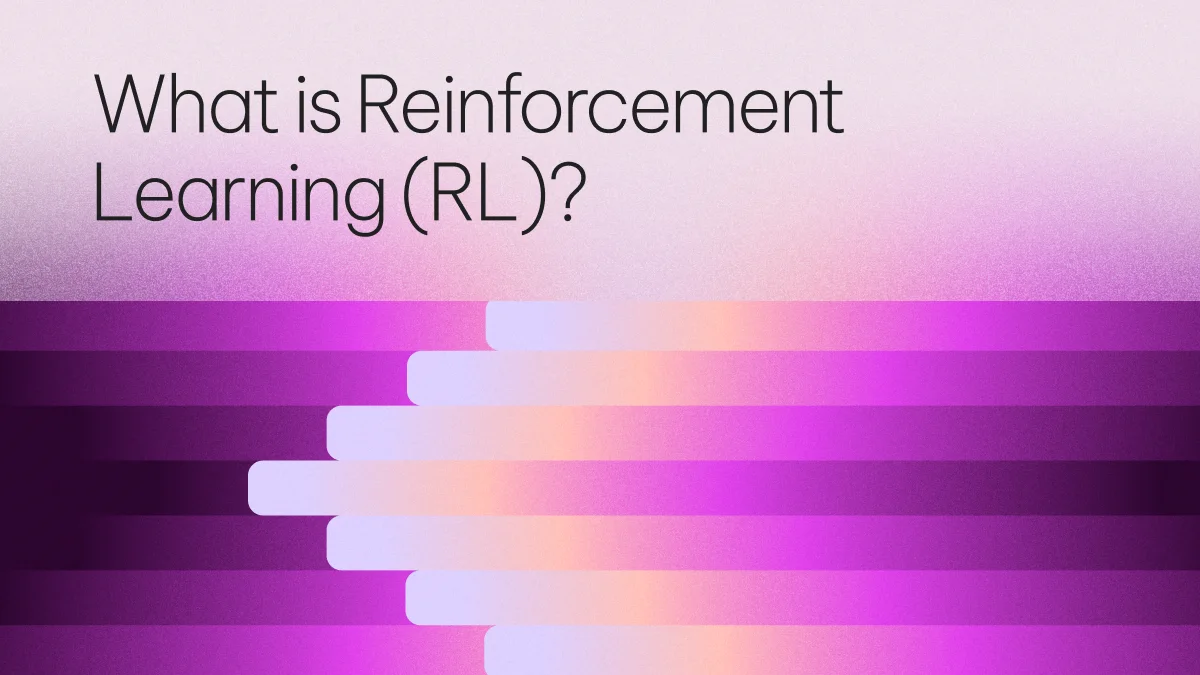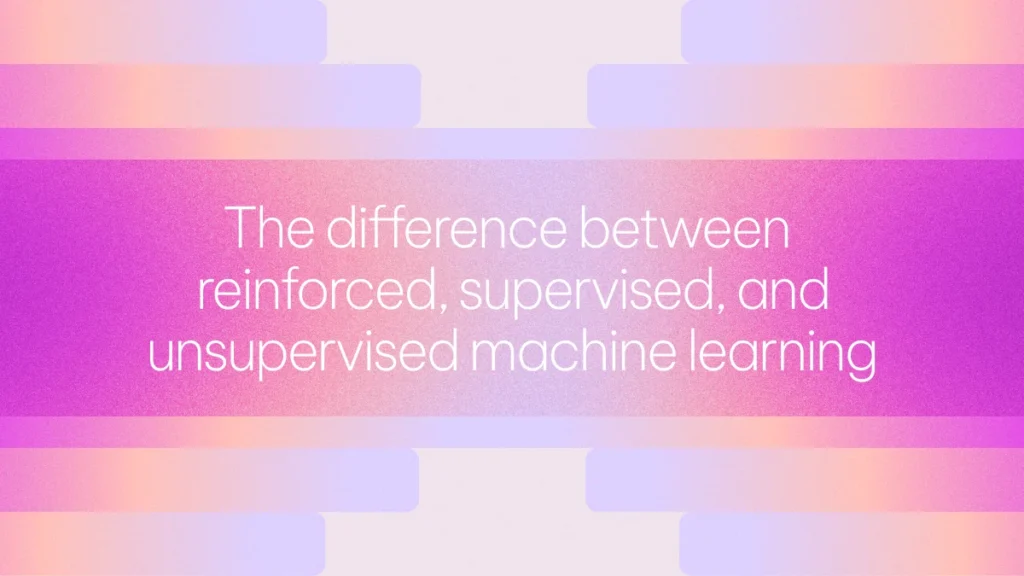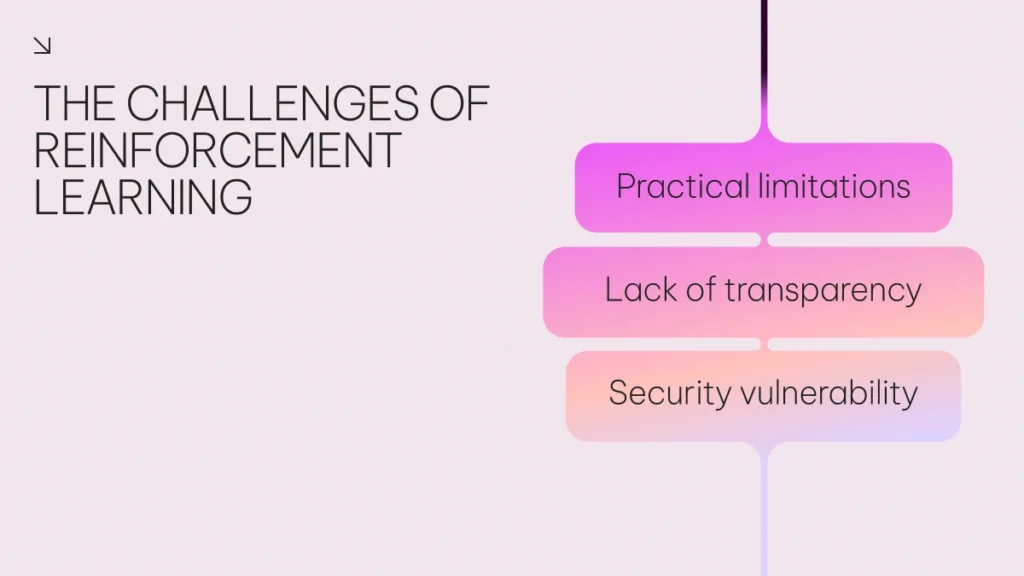Table of Contents

What is Reinforcement Learning? Types & Use Cases
Nearly 60% of companies have implemented software, equipment, or technology to automate tasks previously completed by employees, but traditional rule-based systems quickly hit limits in dynamic environments. Whether it’s chatbots restricted to scripts or fraud detection based on static rules, these tools struggle to adapt in fast-paced industries like finance, healthcare, and retail.
Reinforcement Learning (RL) offers a more flexible approach. Instead of following fixed instructions, RL trains AI agents to learn through trial and error, optimizing decisions based on long-term rewards.
This article explores how enterprises can use RL to drive more innovative automation with real-world use cases and guidance for implementation.
What is reinforcement learning (RL)?
Reinforcement Learning (RL) is a branch of machine learning in which an AI agent learns to make decisions by interacting with an environment. The agent receives feedback in the form of rewards or penalties based on the outcomes of its actions, allowing it to gradually improve its decision-making over time.
Unlike traditional rule-based systems or supervised learning models that learn from labeled data, RL focuses on learning through trial and error to maximize long-term cumulative rewards rather than immediate outcomes. This enables the agent to develop a policy — a strategy for choosing actions — that leads to optimal results over time.
A key challenge in RL is the exploration-exploitation trade-off: the agent must balance exploring new actions that might lead to better strategies with exploiting actions already known to yield strong results.
By modeling how decisions influence future states, reinforcement learning allows AI systems to learn, adapt, and optimize in complex, dynamic environments. In enterprise settings — such as automating trading strategies in finance, personalizing treatment pathways in healthcare, or optimizing supply chains in retail — RL can elevate automation from simple task execution to strategic, goal-driven decision-making.
How does reinforcement learning work?
Reinforcement learning is driven by continuous interaction between an agent and its environment. Rather than learning from labeled examples, the agent learns through experience — by taking actions, receiving feedback, and adjusting its strategy over time to maximize long-term outcomes.
Here’s a simplified overview of the RL process:
- Environment: The agent operates within an environment that defines the rules, constraints, and dynamics of the system. At each step, the environment provides the agent with a state — a snapshot of the current situation.
- Action: Based on this state, the agent selects an action from a defined set of possibilities. This decision is guided by its current policy — a strategy for choosing actions in different states.
- Reward: After taking an action, the environment returns a reward (or penalty), signaling the immediate outcome or value of that decision.
- Cumulative Learning: The agent’s objective is not just to maximize immediate rewards, but to optimize the total reward accumulated over time. This long-term perspective enables the agent to pursue strategies that lead to sustainable, strategic outcomes.
- Policy Improvement: Through repeated interactions, the agent updates and refines its policy — continually improving its ability to make better decisions in future states.
- Exploration vs. Exploitation: A critical aspect of RL is balancing exploration – trying new actions that might lead to better outcomes – with exploitation – leveraging actions that are already known to perform well. This trade-off is essential to avoid stagnation and ensure ongoing improvement.
In enterprise environments, whether it’s optimizing real-time pricing strategies in retail, managing dynamic resource allocation in hospitals, or adjusting portfolio weights in algorithmic trading, RL can be a powerful framework for enabling systems to learn and adapt continuously in response to changing conditions.
Types of reinforcement learning algorithms
Reinforcement learning (RL) encompasses a range of algorithmic approaches that enable agents to learn optimal behavior through interaction with an environment. These approaches are broadly categorized into model-based and model-free reinforcement learning, depending on whether the agent builds an internal model of the environment or learns directly from experience.
Model-based reinforcement learning
In model-based reinforcement learning, the agent creates a simplified version — or model — of the environment it’s working in. This model helps the agent understand how different actions lead to different outcomes, and which of those outcomes are better in the long run.
Once the model is built, the agent can test different actions inside the model before trying them in the real world. This helps it find the best strategy without taking unnecessary risks.
This approach is useful when real-world testing is difficult, expensive, or risky, such as in healthcare, finance, or logistics. For example, in finance, a model-based system can simulate how different investment decisions might play out over time, helping optimize long-term gains without putting real capital at risk.
Model-free reinforcement learning
Model-free reinforcement learning takes a different approach. The agent does not build a model of the environment. Instead, it learns by directly trying different actions and observing what happens. Over time, it determines which actions lead to better results and adjusts its behavior accordingly.
This type of learning is helpful in large, constantly changing environments where it’s hard — or impossible — to build an accurate model. For example, in customer engagement, an RL system can learn which messages, offers, or timing strategies are most effective by experimenting in real time and adapting as customer behavior changes.
What is the difference between reinforced, supervised, and unsupervised machine learning?

Reinforcement learning (RL), supervised learning, and unsupervised learning are distinct machine learning paradigms, each with different learning processes and data requirements.
Reinforcement learning vs. supervised learning
Supervised learning relies on labeled data, where each example includes both an input and the correct output. The system learns to recognize patterns in this data to accurately predict new, unseen examples.
For instance, an eCommerce platform might use supervised learning to classify product images as “shoes” or “boots” based on thousands of labeled examples.
Reinforcement learning, by contrast, doesn’t learn from examples with correct answers. Instead, an agent learns by interacting with an environment, acting, and receiving rewards or penalties based on the outcomes. The goal is to discover which actions lead to the best long-term results.
This makes RL especially powerful for decision-making tasks where the “correct” answer isn’t known in advance, like optimizing investment strategies or managing personalized treatment plans in healthcare.
Reinforcement learning vs. unsupervised learning
Unsupervised learning deals with unlabeled data and aims to find hidden patterns or groupings within that data. It’s commonly used for tasks like customer segmentation, where an algorithm might group users based on shared behavior, such as purchase frequency or product preferences.
However, while unsupervised learning can surface valuable insights, it doesn’t make decisions or take actions. It also doesn’t receive feedback from the environment, so it can’t improve over time in the same way RL can.
Reinforcement learning, in contrast, is focused on learning from outcomes, making it well-suited for applications that require ongoing optimization, such as dynamic pricing, inventory management, or autonomous decision-making systems.
The benefits of reinforcement learning
Reinforcement learning (RL) brings powerful advantages to enterprise use cases, particularly in environments that require continuous adaptation, strategic decision-making, and long-term planning. These benefits arise from RL’s ability to learn through interaction, improve over time, and operate with minimal human intervention.
Achieving complex goal
RL is well-suited to solving problems with multiple variables and competing objectives. Because agents are trained to maximize long-term reward, they can uncover strategies that involve short-term trade-offs in service of bigger-picture goals, such as offering short-term discounts to reduce long-term customer churn.
This makes RL especially valuable in industries like retail, finance, and healthcare, where success depends on optimizing decisions across time, not just in the moment.
Cost efficiency
Unlike supervised learning, which requires large volumes of labeled data, RL learns directly from experience. This reduces the need for extensive human oversight during the training process, lowering both time and cost.
Moreover, by automating complex decision-making tasks, RL frees employees to focus on more strategic or creative work, reducing the burden of repetitive manual processes.
Adaptability to dynamic environments
One of RL’s key strengths is its ability to adapt to constantly changing environments. Whether the context shifts slightly, like market trends, or significantly, like new regulations or customer behaviors, an RL agent can learn and adjust its strategy over time.
This adaptability is particularly useful in sectors like finance, where market conditions shift quickly, and healthcare, where patient needs evolve in real time.
The challenges of reinforcement learning
Despite its possibilities, reinforcement learning also presents several challenges that enterprises need to consider before implementation around practicality, interpretability, and the nature of the learning process itself.

Practical limitations
RL may be unnecessarily complex and resource-intensive for more straightforward use cases. Training agents can require extensive computational power and time, and deploying RL in real-world environments adds further challenges.
Even high-quality simulations can’t perfectly mirror reality. As a result, agents trained in simulated environments may underperform when exposed to unexpected changes in the real world.
Lack of transparency
Many RL models, particularly those involving deep learning, function as black boxes, making it difficult to understand or explain their decisions. While this may be acceptable when everything works smoothly, it becomes problematic when outcomes need to be audited or reversed.
In regulated industries like finance or healthcare, the inability to trace decision logic can raise compliance and risk concerns.
Security vulnerability
RL systems can be susceptible to manipulation. If an attacker can influence the environment or the feedback the agent receives, they may be able to skew its learning process. For example, by feeding misleading signals, a malicious actor could minimize rewards for good behavior — guiding the agent toward unintended or harmful actions.
This risk underscores the need for robust security and monitoring mechanisms, particularly in sensitive or high-stakes applications.
Enterprise use cases for reinforcement learning
Reinforcement learning (RL) is designed to maximize cumulative reward over time, making it well-suited to enterprise environments where decisions have long-term impacts and conditions can shift rapidly. From finance to healthcare to retail, RL is helping organizations unlock more adaptive, intelligent systems.
Finance
In the financial sector, RL excels in environments where outcomes are uncertain, and the number of possible decisions and future states is too large for humans to evaluate manually.
- Portfolio optimization: RL agents can simulate and test investment strategies, adjusting based on market shifts, transaction costs, and risk tolerance.
- Credit and lending: RL models can optimize loan offers or credit limits based on customer behavior and economic indicators, aiming to balance long-term customer value with default risk.
- Algorithmic trading: RL can dynamically adjust strategies in response to real-time market data — learning which signals produce the best long-term returns.
Retail
Retail businesses benefit from RL’s ability to learn from interaction and adapt to changing customer behavior.
- Personalized recommendations: RL powers recommendation engines that continuously adapt to user preferences, refining what content, promotions, or products to show based on browsing and purchasing history.
- Dynamic pricing: RL can automatically adjust prices in real time, factoring in demand patterns, competitor pricing, inventory levels, and customer sensitivity.
- Ad optimization: RL helps decide which banners or promotions to display to which users, learning over time which creative combinations drive conversions or engagement.
Healthcare
RL’s focus on long-term outcomes makes it a promising approach in healthcare, where decisions often unfold over time and real-world experimentation can be risky.
- Adaptive treatment planning: RL can assist in designing treatment strategies that adapt based on patient responses — with the goal of optimizing health outcomes over a treatment cycle.
- Hospital resource allocation: RL can help manage staffing, bed assignments, and equipment usage in response to changing patient volumes or emergencies.
- Medical training: Simulated environments powered by RL can support healthcare professionals in refining clinical decision-making, offering feedback and adaptive scenarios without real-world consequences.
While many RL applications in healthcare are still in the early stages or are under research, the potential is significant, especially in high-stakes, data-rich environments where decision quality directly impacts lives.
Reinforcement learning: Adoption in enterprise
Adopting reinforcement learning (RL) requires a shift in mindset from traditional machine learning approaches. Unlike supervised learning, which depends on labeled data, or unsupervised learning, which uncovers patterns, RL learns through continuous interaction and feedback. This makes RL inherently more dynamic and experimental, demanding a greater tolerance for iteration and real-time learning.
To fully capitalize on RL, enterprises should invest in scalable infrastructure, including the frameworks and computing resources required to train and deploy RL models effectively.
Ultimately, RL offers a powerful opportunity for organizations ready to embrace a long-term, adaptive approach to AI, enabling more intelligent automation, greater operational efficiency, and a sustained competitive advantage.
FAQs
-
The primary goal of reinforcement learning (RL) is to train an agent to make decisions that maximize cumulative rewards in a dynamic environment. The agent learns through trial and error, receiving feedback in the form of rewards or penalties, and adjusts its actions over time to improve outcomes./i


